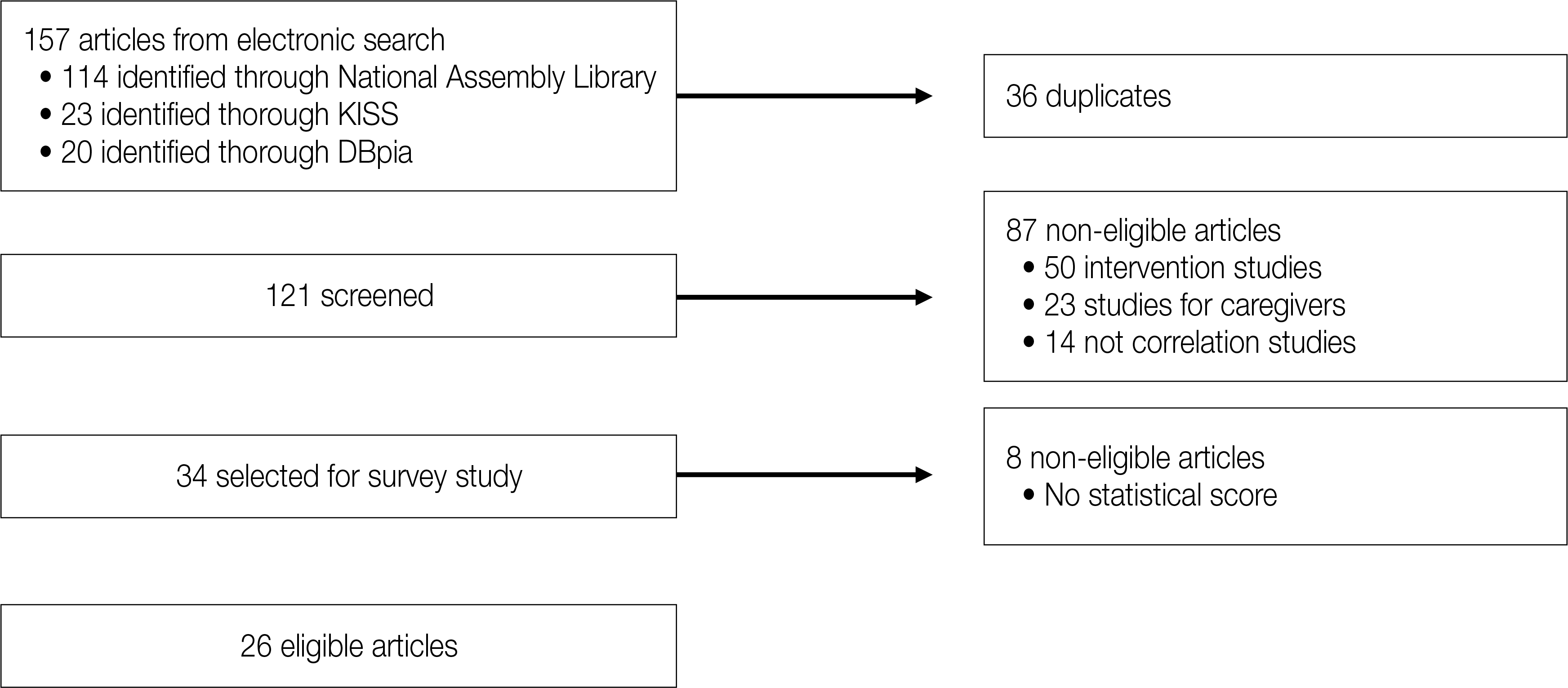Abstract
Purpose
The purpose of this study was to use meta-analysis to evaluate the variables related to depression in patients who have had a stroke.
Methods
The materials of this study were based on 16 variables obtained from 26 recent studies over a span of 10 years which were selected from doctoral dissertations, master's thesis and published articles.
Results
Related variables were categorized into sixteen variables and six variable groups which included general characteristics of the patients, disease characteristics, psychological state, physical function, basic needs, and social variables. Also, the classification of six defensive and three risk variables group was based on the negative or positive effect of depression. The quality of life (ES= -.79) and acceptance of disability (ES=-.64) were highly correlated with depression in terms of defensive variables. For risk variables, anxiety (ES= .66), stress (ES= .53) showed high correlation effect size among the risk variables.
Go to : 
References
Angelelli P.., Paolucci S.., Bivona U.., Piccardi L.., Ciurli P.., Cantagallo A., et al2004. Development of neuropsychiatric symptoms in poststroke patients: A cross-sectional study. Acta Psychiatrica Scandinavica. 110:55–63. http://dx.doi.org/10.1111/j.1600-0447.2004.00297.x.

Borenstein M.., Hedges L. V.., Higgins J. P. T.., Rothstein H.R. 2009. Introduction to meta-anaylsis. West Sussex, UK: Wiley.
Bruggimann L.., Annoni J. M.., Staub F.., von Steinbuchel N.., Van der Linden M.., Bogousslavsky, J. 2006. Chronic posttraumatic stress symptoms after nonsevere stroke. Neurology. 66:513–516. http://dx.doi.org/10.1212/01.wnl.0000194210.98757.49.

Carson K. P.., Schriesheim C. A.., Kinicki A.J. 1990. The usefulness of the "fail-safe" statistic (N) in meta-analysis. Educational and Psychological Measurement. 50:233–243.
Carter A.C. 2004. Post stroke depression. Journal of Psychosomatic Research. 56:634.
Chau J. P. C.., Thompson D. R.., Twinn S.., Chang A. M.., Woo, J. 2009. Determinants of participation restriction among community dwelling stroke survivors: A path analysis. BMC Neurology. 9(49):1–7. http://dx.doi.org/10.1186/1471-2377-9-49.

Cohen, J. 1977. Statistical power analysis for the behavioral sciences. New York, NY: Academic Press.
Dafer R. M.., Rao M.., Shareef A.., Sharma, A. 2008. Poststroke depression. Topics in Stroke Rehabilitation. 15:13–21. http://dx.doi.org/10.1310/tsr1501-13.

Hackett M. L.., Anderson C.S. 2005. Predictors of depression after stroke: Systemic review of observational studies. Stroke. 36:2296–2301. http://dx.doi.org/10.1161/01.STR.0000183622.75135.a4.
Huffcutt A. I.., Arthur W. Jr. 1995. Development of a new outlier statistic for meta-analytic data. Journal of Applied Psychology. 80:327–334.

Jordge R. E.., Robinson R. G.., Arndt S.., Starkstein, S. 2003. Mortality and poststroke depression: A placebo-controlled trial of antidepressants. American Journal of Psychiatry. 160:1823–1829.
Kim J.H. 2008. Relationship among sexual knowledge, frequency, satisfaction, marital intimacy and levels of depression in stroke survivors and their spouses. Journal of Korean Academy of Nursing. 38:483–491. http://dx.doi.org/10.4040/jkan.2008.38.3.483.

Kim J. H.., Kim, O. 2008. Influence of mastery and sexual frequency on depression in Korean men after a stroke. Journal of Psychosomatic Research. 65:565–569. http://dx.doi.org/10.1016/j.jpsychores.2008.06.005.

Kimura M.., Robinson R. G.., Kosier J.T. 2000. Treatment of cognitive impairment after poststroke depression: A double-blind treatment trial. Stroke. 31:1482–1486. http://dx.doi.org/10.1161/01.STR.31.7.1482.
Kwon S.M. 2004. Depression. 4th ed.Seoul: Hakjisa.
Law M.., Stewart D.., Pollock N.., Letts L.., Bosch J.., Westmoreland, M. 1998. Critical review form-Quantitative studies. Retrieved September 13, 2011, from. http://www.srs-mcmaster.ca/Portals/20/pdf/ebp/quanreview_form1.doc.
Lee D. J.., Ko T.S. 2010. Relationships between symptoms of depression and cognitive function, physical functions, and activities of daily living in stroke patients. Journal of Special Education & Rehabilitation Science. 49(4):159–178.
Lee W.J. 2004. Adjustment of middle-aged people with hemiplegia after stroke. Unpublished doctoral dissertation;Seoul National University;Seoul:
Nys G. M.., Van Zandvoort M. J.., De Kort P. L.., Jansen B. P.., Van der Worp H. B.., Kappelle L. J., et al2005. Domain-specific cognitive recovery after first-ever stroke: A follow-up study of 111 cases. Journal of the International Neuropsychological Society. 11:795–806. http://dx.doi.org/10.1017/S1355617705050952.

Orwin R.G. 1983. A fail-safe N for effect size in meta-analysis. Journal of Educational Statistics. 8:157–159.

Park E. Y.., Shin I.S. 2011. The effects of transitional education programs on adaptive behavior in students with developmental disabilities: A meta analysis. Disability & Employment. 21:59–78.
Rosenthal, R. 1979. The file drawer problem and tolerance for null results. Psychological Bulletin. 86:638–641.

Salter K.., Bhogal S. K.., Foley N.., Jutai J.., Teasell, R. 2007. The assessment of poststroke depression. Topics in Stroke Rehabilitation. 14(3):1–24. http://dx.doi.org/10.1310/tsr1403-1.

Singh A.., Black S. E.., Herrmann N.., Leibovitch F. S.., Ebert P. L.., Lawrence J., et al2000. Functional and neuroanatomic correlations in poststroke depression: The sunnybrook stroke study. Stroke. 31:637–644. http://dx.doi.org/10.1161/01.STR.31.3.637.
Sterr A.., Herron K.., Dijk D. J.., Ellis, J. 2008. Time to wake-up: Sleep problems and daytime sleepiness in long-term stroke survivors. Brain Injury. 22:575–579. http://dx.doi.org/10.1080/02699050802189727.

Sung T.J. 2005. Education research methodology. Seoul: Hakjisa.
Teoh V.., Sims J.., Milgrom, J. 2009. Psychosocial predictors of quality of life in a sample of community-dwelling stroke survivors: A longitudinal study. Topics in Stroke Rehabilitation. 16(2):157–166. http://dx.doi.org/10.1310/tsr1602-157.

Verdelho A.., Henon H.., Lebert F.., Pasquier F.., Leys, D. 2004. Depressive symptoms after stroke and relationship with dementia: A three-year follow-up study. Neurology. 62:905–911. http://dx.doi.org/10.1212/01.WNL.0000115107.66957.8C.

Warlow J.., van Gijn M.., Dennis J.., Wardlaw J.., Bamford G.., Hankey P., et al2007. Stroke practical management. Malden, MA: Blackwell publishing.
Go to : 
Table 1.
Summary of Characteristics of Studies Included Meta-analysis
Table 2.
Effect Size of Defensive Sub-variables related to Depression
Table 3.
Effect Size of Defensive and Risk Variables according to Categories
K=Number of the effect size; ES=Effect size; BDI=Beck depression inventory; CES-D=The Center for Epidemiological Studies-Depression Scale; GDSSF-K=Geriatric Depression Scale Short Form Korea Version; HRDS=The Hamilton Rating Scale for Depression; SDS=Zung Self-Rating Depression Scale; FSN=Fail safe N; CI=Confidence interval.
Table 4.
Effect Size of Risk Sub-variables related to Depression




 PDF
PDF ePub
ePub Citation
Citation Print
Print



 XML Download
XML Download